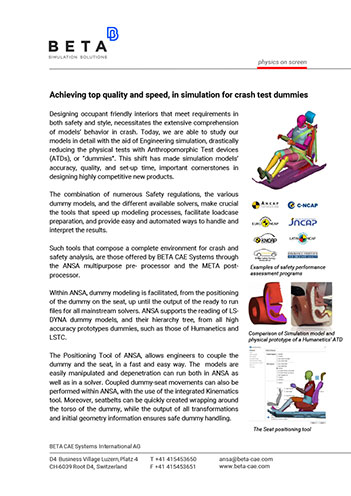CAE Platform Has a Direct Modeling and Meshing Engine
Pre-processing and Meshing News
Pre-processing and Meshing Resources

October 8, 2014
MSC Software has released MSC Apex, its next-generation CAE platform. The application platform, the company says, is the world’s first computational parts-based CAE system. MSC Apex, adds the company, will serve as “the platform for a broad range of physics and applications MSC will introduce over time.”
MSC describes computational parts as mathematical models that represent the behavior of a part independently from the other parts in an assembly. A computational part has a boundary where it connects to other parts and sensors where users define key metrics to be recovered.
The MSC Apex platform enables predictive product development from the early design stages, which can reduce CAE modeling and process time from days to hours as well as save money. MSC Apex provides a fully integrated and generative simulation environment. Built from the ground up, this environment allows users to leverage end-to-end simulation workflows with full associativity between geometric and analysis data, according to the company. These MSC Apex attributes, says MSC, can accelerate the CAD-to-mesh process by a factor of up to 50 times.
To help engineers achieve this level of efficiency, the MSC Apex platform features a CAE-specific direct modeling and meshing engine that, says MSC, provides a complete set of direct modeling tools to simplify geometry cleanup and idealization. The company explains further that MSC Apex supports integrated solver methods that help users interactively validate parts and subsystem models. In hands-on terms, this means that engineers can run incremental analysis of parts and subassemblies as a design progresses, which eliminates the need to submit jobs repeatedly and allows for rapid structural layout trade studies.
MSC describes MSC Apex as a parts and assemblies model representation-centric solution. This means that models do not have to explicitly represent a part’s geometry or material properties. This attribute, MSC adds, lets groups of users exchange mathematical models in and through the supply chain without compromising intellectual property.
Users have three model fidelity options for exchanging computational parts and assemblies. First, as a public model that includes shape, material model and behavior data. Next, as a semi-secret model that provides shape and behavior data. Finally, users can classify parts and assemblies to be distributed as secret parts with only behavioral information transmitted to collaborators. Additionally, domain experts throughout the supply chain can share a product structure and independently manage instances of parts, subsystems, full assemblies and their corresponding multi-fidelity behavioral representations.
MSC Apex will work as a complement with the Patran pre- and post-processing software for FEA (finite element analysis) and the MSC Nastran multidisciplinary structural analysis application. It supports BDF file import and export for data migration, facilitating its integration into existing tool chains that incorporate Patran and MSC Nastran, according to MSC. MSC Apex can also export to the Parasolid format.
The company adds that MSC Apex provides a set of import tools for standard data formats such as IGES, STEP and Parasolid. Also available are interfaces for CAD vendor-specific data formats, including Autodesk Inventor, CATIA V4/V5 from Dassault Systèmes and SolidWorks, PTC Creo, NX from Siemens PLM Software and SolidWorks from Dassault Systèmes.
MSC Apex deploys with a user interface approach that allows for a 10 time reduction in tools, according to MSC. Usability and learning features include built-in video tutorials, workflow instructions and at-mouse guidance. The company reports that it’s possible for non-CAE experts to learn MSC Apex software in a day.
The current MSC Apex product line-up contains two solutions, MSC Apex Modeler and MSC Apex Structures. Available immediately, MSC Apex Modeler provides CAE-specific direct modeling and meshing functionality for streamlining CAD cleanup, simplification and meshing workflow. Not yet available for purchase but reportedly coming soon, MSC Apex Structures will deliver a fully integrated and generative structural analysis solution for engineers and analysts.
“The patterns that were developed 30+ years ago for simulation have simply not evolved to keep pace with the tremendous challenges that industry faces today,” said Dominic Gallello, president and CEO of MSC Software, in a press statement. “We rethought the process, and have found many opportunities to deliver dramatic productivity improvements to engineers and analysts. Our team rearranged the way in which the components of geometry modeling, solving, and post-processing relate to each other, moving away from a serial process to an interactively connected process based on a new parts and assembly paradigm.”
MSC Software created a dedicated, multimedia web-landing page for MSC Apex. On the page are numerous videos, registration forms for a complimentary trial version of MSC Apex and a private demonstration as well as a link to sign-up for a live introductory webcast to be held Thursday, October 9.
Access the MSC Apex landing page here.
Click here to learn more about MSC Apex Modeler.
Click here to learn more about MSC Apex Structures.
Sign up for the “MSC Apex Methods for Simpler FE Meshing, Aerospace Applications” live webinar here.
See why DE’s Editors selected MSC Apex as their Pick of the Week.
Sources: Press materials received from the company and additional information gleaned from the company’s website.
Subscribe to our FREE magazine, FREE email newsletters or both!
About the Author
Anthony J. Lockwood is Digital Engineering’s founding editor. He is now retired. Contact him via [email protected].
Follow DE








